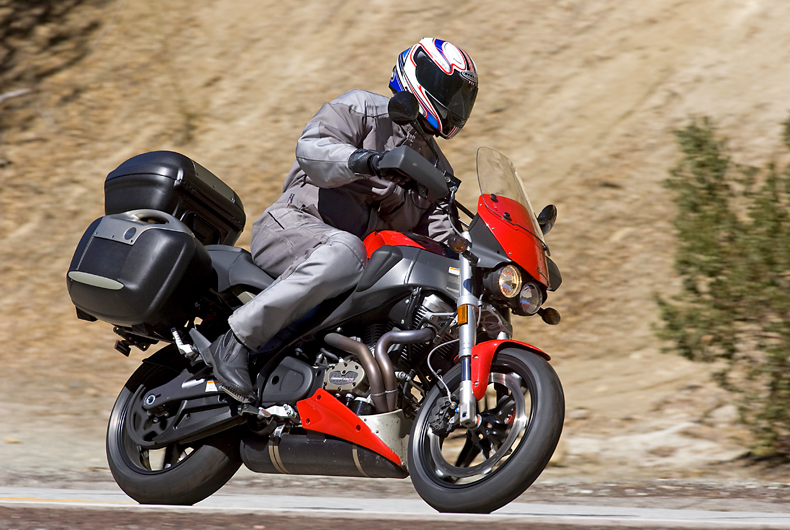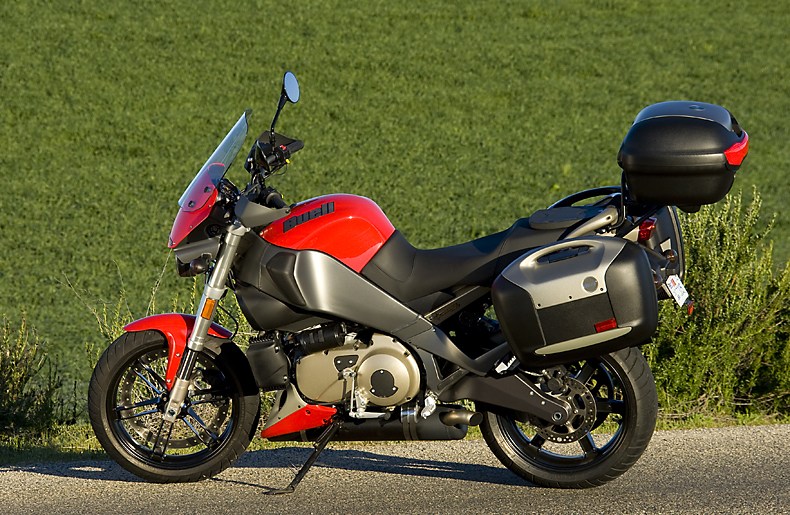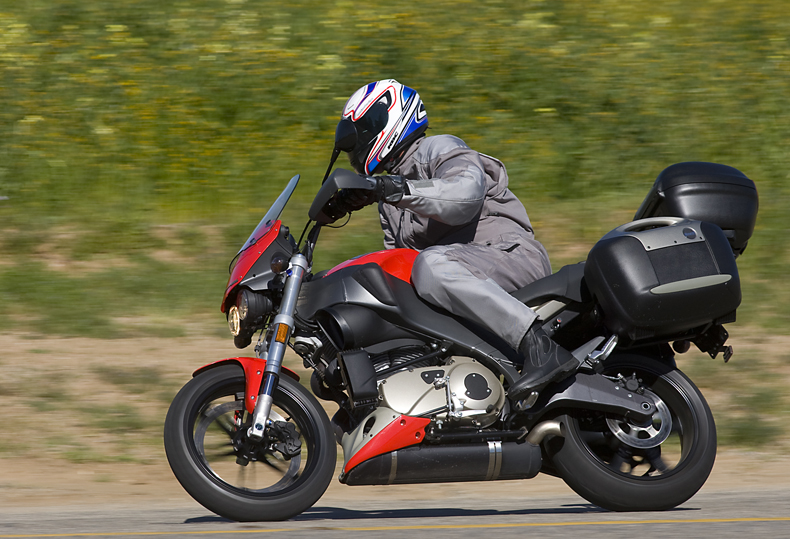
Cynics might be tempted to dismiss the Buell Ulysses XB12XT as just a mildly retooled model variation of the Ulysses XB12X dual-purpose model (itself an offshoot of the XB12 Lightning and Firebolt streetbikes). After all, the frame, engine and swing arm are identical. But differences are as important as similarities, and the XT model has a 1.1-inch lower seat height (at 30.7-inches) than the 12X, a taller windscreen (by four inches), and Pirelli Diablo Strada tires.
Strada is Italian for Street, in case you didn’t know, emphasizing this bike’s intended role as a sport tourer. Appropriate to that role, Buell has equipped the XT model with a fully adjustable 43mm inverted Showa front fork with triple-rate fork springs for progressive wheel control. A coil-over monoshock from the same supplier controls the rear wheel, and while it is similarly adjustable for compression and rebound damping, there is also a handy remote spring preload-change knob that quickly compensates for two-up riding or heavy luggage with just a quick twist.

Since the 12XT is not going to be bounding along goat paths, the suspension has less travel (4.9 vs. 6.5-inches), and the bike requires less ground clearance. For the same reasons, the Enkei cast aluminum wheels have lighter rim sections for reduced rotational mass and lower unsprung weight-both of which are known to ease handling transitions. Erik Buell’s famous ZTL front-brake system with its rim-mounted rotor is retained along with the familiar underslung exhaust and belt final-drive system.
In keeping with the bike’s role as a tourer, the top and side cases you see in these pictures are standard equipment. All three are large enough to accommodate a full-face helmet, and have convenient mounting and latching systems. Because these cases are essentially the same type as those made available to other Ulysses 12X models as accessories, they require a separate key for operation. Other than that minor consideration, the convenience of standard luggage is hard to overstate.

The “Uly” 12XT comes standard with heated handgrips as well as knuckle-guards. The later provide some wind cover along with protection against harder objects like branches or highway shrapnel. There is a 12-volt power socket on the dash and another under the seat, and Buell sells a specially adapted Garmin navigation system that bolts right on.
As with all of Buell’s 2008 models, the XB12XT’s Thunderstorm engine benefits from some technical revisions, including an increase in crankpin thickness from 1.25-inches to 1.5-inches, an improved oiling system, a new Walbro DDFI fuel injection system, and a progressive throttle cam.
Otherwise, the famous Harley-sourced V-twin is the same hoary brute beloved by many, and in this form it is capable of 103 horsepower at 6800 rpm, and 84 pound-feet of torque at 6000 rpm. In all of the Ulysses models the engine is a stressed part of the chassis, despite being rubber mounted to reduce vibrations.
But, vibrate it does. For anyone not familiar with the 45-degree V-twin used in most of the Buell motorcycles, the vibration that ensues after you’ve pressed the starter button can be disconcerting. The front wheel oscillates visibly and the whole bike shakes like a washing machine trying to spin a badly unbalanced load of laundry.

We’re tempted to suggest that this level of vibration would be considered unacceptable by motorcycle manufacturers in other parts of the world, but there are a couple of aspects to consider. Firstly, the Buell guys say that many survey respondents like this characteristic Milwaukee motor boogie. It certainly hasn’t dissuaded the multitude of Harley riders, and seems to be just part of the cruiser folklore that’s spilled over into Buell’s area of influence.

Secondly, the big twin doesn’t vibrate intensely at all engine speeds. Indeed, at about 3,000 rpm, the 1203cc motor feels smooth and supple, answering the throttle with a fluid wave of power. At other engine speeds, the vibration is relative to throttle position. You can let the twin idle along at just over 1,000 rpm on a barely cracked throttle with minimal tremors. But any big application of throttle at low engine speeds will get you seismic vibes along with the torquey throttle response for which the engine is famous.
Torque there is aplenty. There isn’t much call for frequent trips to redline with this engine, and the five-speed transmission seems entirely adequate to the task, given the big twin’s broad operating range. Still, you run out of revs pretty quickly when you are hurrying as the rev limiter steps in decisively just beyond the 7100 rpm mark.
Gear shifting on our demo machines was positive, and although you might not describe the action as light, the lever feel is at least constant throughout its throw. I never missed a gear once, and the only criticism I heard was that the selection of neutral is made slightly difficult by the deliberate weight of the mechanism. The effort required to overcome its resistance causes you to shoot through neutral. At least, on these barely broken-in demo bikes it did.

The 12XT feels great on the road. The medium-rise handlebars suited this 6-foot-5 rider very well, providing a riding position that was both comfortable and well-matched to the layout of the various controls. After we dialed up a touch more rear rebound firmness to stop a mild see-sawing effect, the 12XT’s ride-motion control was pretty good, providing a reassuring combination of control and compliance.

The triple-rate fork springs did a nice job of reducing dive under braking, and the whole package could be flung into turns with real commitment. There’s plenty of cornering clearance, and the Pirelli tires provided good grip with confidence-inspiring feedback from the contact patches. Erik Buell’s strange front brake worked well too, if with less initial bite than we get on leading sportbikes these days. But the lever produced linear increases in braking force as pressure is added, and signaled a clearly discernible lockup threshold.
Although the seat height is slightly lower on the 12XT, the seat boasts the same spacious area as on the “off-road” Ulysses, and spreads the load nicely to avoid hotspots. That compact windscreen helped fend off the worst of the windblast without buffeting turbulence at my face shield. In fact, if the number of squashed bugs is any indication, one’s helmet obviously rides in clear air.
A peculiarity of 12XT operation is the electric fan that kicks in loudly to draw hot air away from the cylinderheads when temperatures start to climb, or when slow traffic reduces the airflow around this big, air- and oil-cooled twin. It cycles briefly when you switch off at the roadside, uttering a brief siren cry as it does, reminding the rider of the engine’s basic configuration.
Air cooling, pushrods, two valves per cylinder, five-speed transmission-it all looks pretty ancient on paper. But the 1203cc twin has earned the company a J. D. Power award for its contribution to the low cost of Buell ownership, and the fuel economy and emissions performance is pretty impressive. The EPA estimates 47 mpg and 59 mpg in urban and highway environments, respectively, promising a range well over 200 miles from the 4.4-gallon in-frame fuel tank. And with hydraulic valve-lash compensation, there is precious little maintenance needed.
These are all meaningful attributes when you’re on the road to somewhere far away, bags filled with belongings, head filled with a need to keep moving. With an MSRP of $12,995, the Buell Ulysses XB12XT isn’t exactly dirt cheap, but for those looking for a semi-naked bagger with a lot of home-grown charm, it may be right on the money.
For additional details and specifications, visit Buell’s web site here.





